by Tom Laemlein
A couple of years ago, I wrote a short article for Small Arms Review magazine on the strangely futuristic “Model 45A”, which was the subject of a group of photos by a US Army photographer. Apparently this rifle was a one-off developed by a group of Army Ordnance men stationed in the Philippines during 1945, and as bizarre as its modern features the Model 45A attracted the attention of a Signal Corps photographer. The rifle ended up being the subject of at least two “photo-shoots” in immediate post-war Manila.
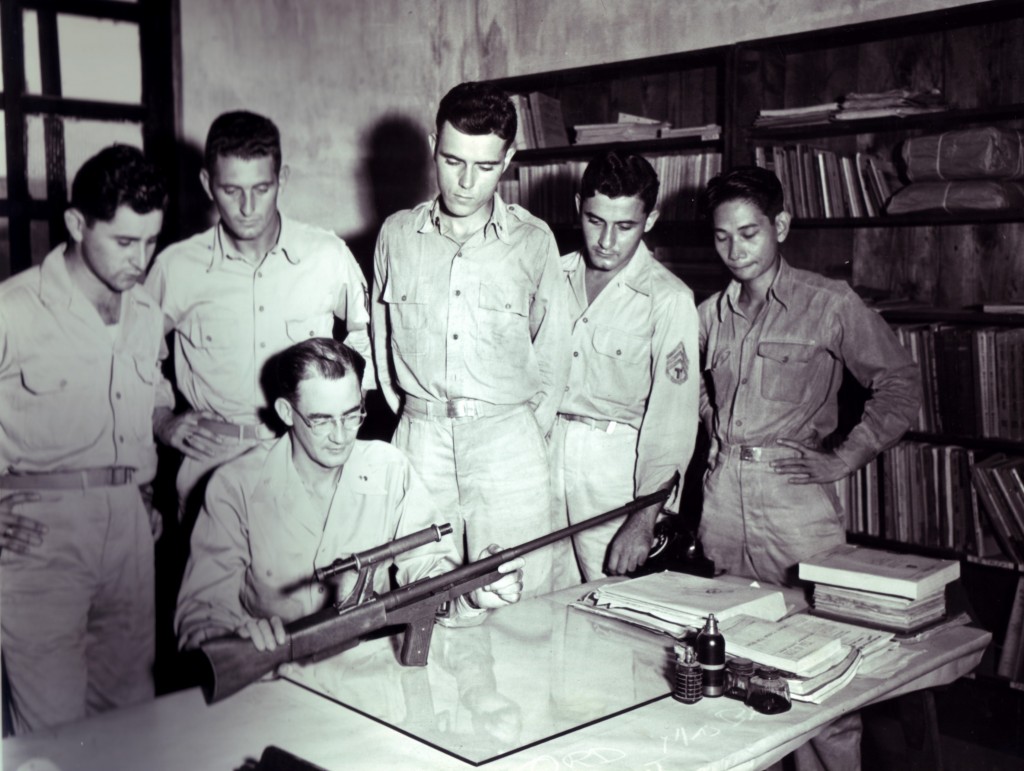
Although there is no way to know for sure, it is unlikely that Model 45A was actually capable of firing. That has been the opinion of several gun writers—at least given the only evidence we have, which are the photos. Consensus of opinion on the Model 45A has been consistent in at least one aspect: the rifle concept presents many forward-thinking ideas in small arms design. The elusive idea of creating an infantry arm that fulfills multiple roles using the same cartridge was alive and well in 1945.
Here’s a short breakdown on what I see in this design: The Model 45A is a modern-looking “Bullpup” design, with a noticeably long barrel. A Browning Automatic Rifle magazine has been used and we can safely assume that the Model 45A was chambered for standard .30 caliber ammunition. The pistol grip is futuristic looking for 1945, but the receiver cover looks rather crude and flimsy, and this is likely why the Model 45A is probably not a live gun. The scope integrated inside the carry handle (very much reminiscent of a modern Steyr-AUG design) is unidentified. The Model 45A is even equipped to launch the M9A1 anti-tank rifle grenade. Produced in the Philippines, it carries with it that country’s long history of hand-made firearms and unique designs.
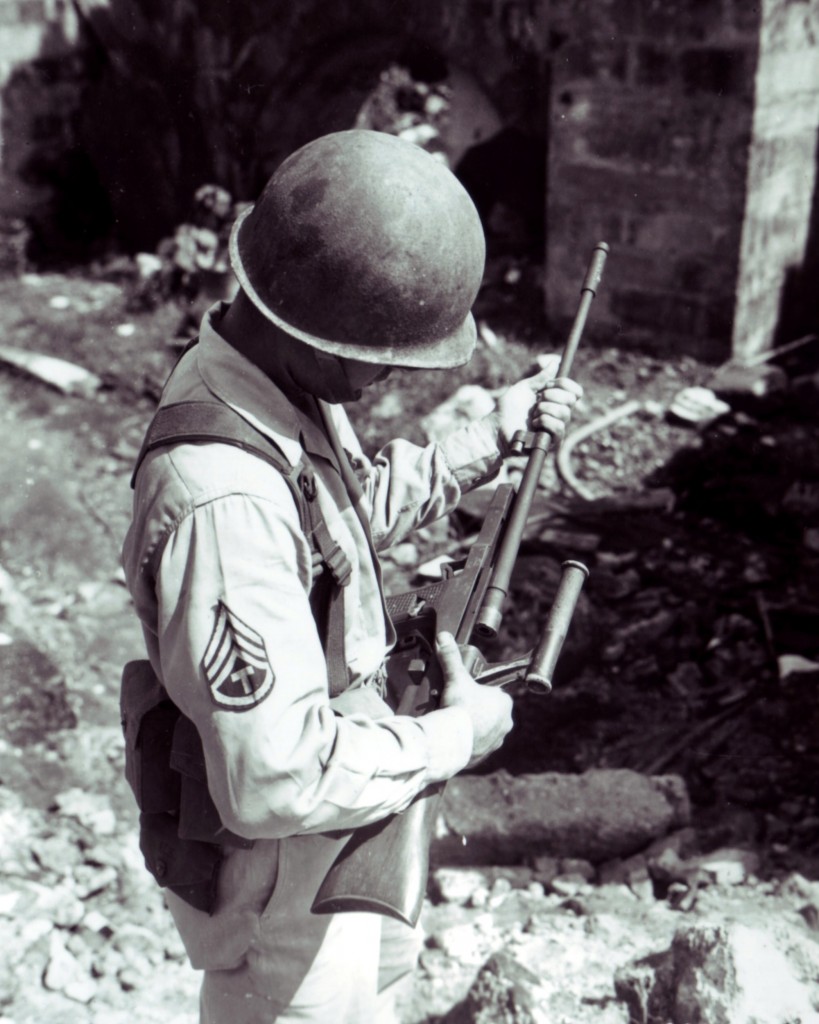
As a photo researcher, I found it quite curious that so many photos were taken of the Model 45A, and that the official captions on the Signal Corps images provided so much information (such as it was) about the rifle. Ultimately, it had the “feel” of a marketing effort. Apparently the Ordnance crew that developed this concept didn’t realize that any designs you come up with while in the employ of Uncle Sam are destined to be US Government property without additional compensation to the designer. If they had dreamed of financial gain by selling the plans of the Model 45A to the Army, it never happened—and never really had any chance of happening anyway.
I find the futuristic appearance of the weapon to be particularly interesting, and the Model 45A goes to prove an important point: American ingenuity knows no bounds!
If ever there was a “forgotten weapon” it is the Model 45A. Maybe one of the readers of this site can share shed some more light on this fascinating concept, developed in the field all those years ago.
Tom Laemlein runs Armor Plate Press, a military history publishing company that specializes in producing photo studies of 20th Century weapons systems. Find his work at www.armorplatepress.com.

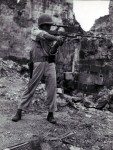
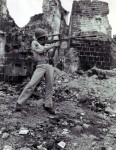
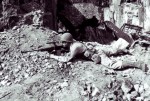
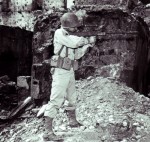
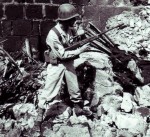

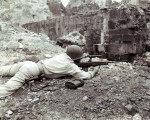
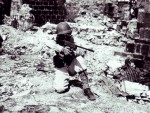
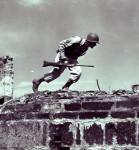
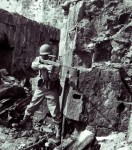
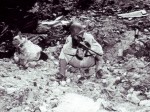
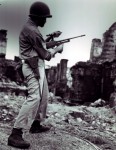
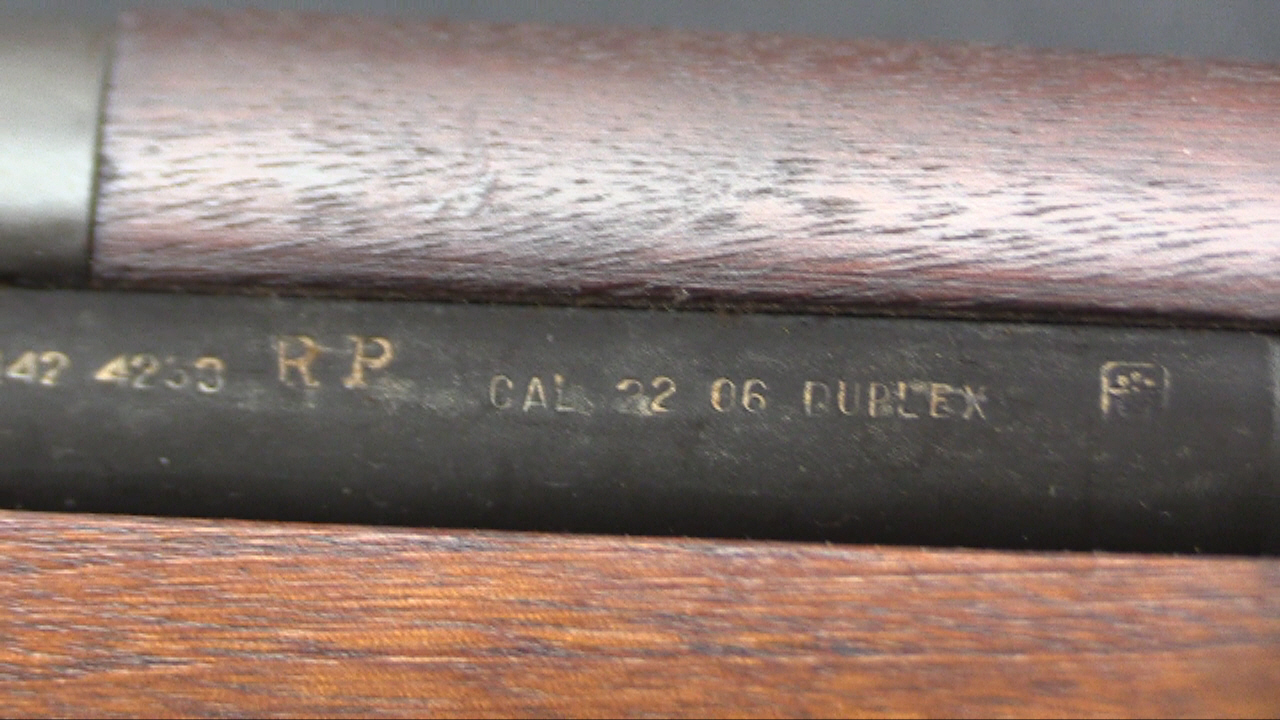

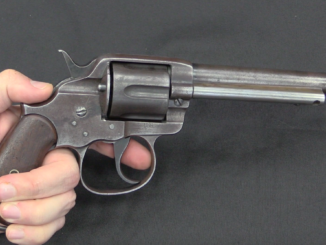
It might not have been a marketing effort for financial gain but for recognition by the Army establishment. Official armor development offices in the states probably had as much “not developed here” resentment to external projects as most large organizations.
What’s odd to me the pistol grip looks to be too far forward for good ergonomics. Makes me wonder if the long barrel was simply to balance the gun for one-handed carry on the handle. But the collection of features, pistol grip, bull pup arrangement, carry handle and integrated optic, is amazing, at least 20 years ahead of its time.
It does look far forward.
That position would help with that stance of holding the base of the pistol grip with the other hand, it shows alot.
Might of been a good design for an intermediate cartridge such as the 7.92×33 or 7.62x39mm, especially if it was easy and simple to manufacture.
The years following war (particularly victorious) are the worst time to put new design in to production. It is true that in USSR the SKS firing 7.62×39 was developed and put into mass production during the end of WW2, but it was done mainly to replace aging Mosin rifle and Mosin carbines. The US Army has M1 Garand rifles designed designed in 1930s and produced in 1940s so it is obvious that replacing the rifles having few years looks not like viable option, not to mention that size of M1 rifles stocks.
In layout and concept, the 45A resembles Melvin Johnson’s recoil-operated carbine in .30-06;
http://milpas.cc/rifles/ZFiles/Semi-automatic%20Rifles/US/Johnson%20Carbine/3.jpg
Except that the 45A appears to be a “true” bullpup, with the action and magazine aft of the pistol grip.
Exactly how it works I can’t tell. It could be gas-operated, like a BAR, but frankly the bolt looks suspiciously like it came from a Johnson M1941, which makes me wonder if it wasn’t recoil-operated. In fact, it could be a Johnson ’41 action taken out of its stock, altered to take a BAR magazine, and fitted with a Johnson-type pistol grip and a shoulder stock which looks very like that of the later Australian X3/F1 postwar 9mm SMG.
If so, there wouldn’t be anything “patentable” about it. It would just be a rather peculiar “field variant” of the Johnson.
I noticed that the photo of the man shooting around a corner shows him firing off the right shoulder. From this I conclude that as with most bullpups even today, firing off the left shoulder wasn’t a viable option.
cheers
eon
I couldn’t find a picture of the bolt eon?
Click on the last picture on the bottom right. When expanded it gives a pretty good look at the action.
The large picture at top showing the barrel detached would tend to indicate a gas-operated action; note the block under the barrel which certainly looks like a gas take-off. But the barrel attachment lockup looks suspiciously Johnson-like.
Possibly a Johnson action altered to gas operation?
cheers
eon
I am on a cellphone, I can see 12 smaller pictures and two larger ones above them, the last one bottom right for me shows a guy in firing from the hip picture at something higher up than him. Can’t find a bolt picture…
Like you say though it does appear to have a gas port/plug thing. The gas piston would have to split in order to run either side of the magazine, or run along just one side of it sort of M14 style. There’s a bar on the left hand side of it running from the trigger area back, wonder if that’s the trigger bar.
On said photo “he’s holding the scope, tube mount thing underhand” you can see under the barrel and there appears to be a lug type thing running underneath it, and you can see that block object in front of the mag well has cut out through it you can see sky.
Maybe you remove the mag, pull it down then back, over the mag well, which would mean it has an open bolt… Might not do that, seems a bad design. Trying to find a cocking handle and ejection port.
Actually that one hasn’t got the forestock thing on.
The guy in the photo sat down with the glasses, is that John Garand? Google up an image of him, I think it might be.
Baring something very clever, if this used a Johnson action, it could not have used the original recoil action (so if it is a real gun, and does involve a Johnson action, it must have been converted to gas). In the Johnson rifle there is a recoil spring the length of the butt stock, no where to put it in a bull pup configuration.
As much as I would like to think it is real, it just seems to be a mock up. No photos of the action, or how to field strip it. (The Johnson field stripping was to pull the barrel out, but if this was gas operated, there would be more to it.) No photo of it firing. The scope mount looks to be too high, if someone went to the trouble of making a real rifle one would think they would have gotten more details right.
The L-shaped bit, if it is a gas port, could have been a disconnect rather like a Bren LMG’s. Or it may have been adapted from the gas-port cutoff of an M1 Garand, used to launch rifle grenades.
Just a guess.
cheers
eon
The Fg42 gas thing was merely a hole in the lower part of the barrel going into a gas tube beneath it, which acted directly on that short piston, with a further hole through the tube to vent gas. This would have a short piston also presumably, so maybe it was along the same simple lines. The short plug could fit into the pistons end cap and blast it back venting almost simultaneously, the piston must be shaped in a manner to pass the magazine like say a sawn off BAR piston, the pistons cap could have a hole in it for the springs guide rod to pass through.
Actually there’s multiple ways to fold a jlmg or JSAR’S recoil assembly.
First there’s the m231 firing port weapon approach, I know it’s “common knowledge” in the firearms community that nested spring buffers are “impossible”, however like most other common knowledge in the industry its total bull excrement.
There’s one or two other ways also, but not writing a book here. Also given the time period I would not put it past Melvin Johnson to have sent prototype m1944 and other prototype components forward to the front just like daisy Mae the jlmg type action with a helical magazine instead of his single stack lmg magazine.
Honestly though I’ve alwy believed 45a was built and used in limited numbers by the phillipino gun work shops possibly after the GI’S left.
the US Model 45A looks like a simplified BAR in bullpup configuration
The Bar’s piston rod to pass the magazine would work, is the receiver high enough though, it looks quite fat but not that high…
From the rear of the magazine to the end of the metal part of the receiver isn’t that long either, suggesting the bolt would have to travel into the stock.
I wonder if it’s on it’s side, the BAR bolt and ejects on the left hand side of the magazine downwards, the bolt would move horizontally from right to left then back.
I’m saying it’s based on an improved T31, and I reckon the inventor was trying to make it ambidextrous.
It can’t be based on the T31, because that began development in 1946 and this rifle was photographed in 1945…
Well this model 45A might well be just a “model” explaining a lack of visible parts required i.e. A cocking handle and ejection port, and in that respect if it is real the T31 has similarities in this respect – no ejection port visible, and possibly some sort cocking handle underneath forward of the magazine well.
Out of interest that T31 is a head scratcher I found one other picture of it and it appears to have a normal magazine port, with no ejection port to one side of it for example, neither does it have a port on the underside of the stock. The right hand side of the weapon just doesn’t seem to have a ejection port, the middle piece appears to be part of the receiver and the parts above and below don’t seem wide enough. It can’t eject upwards, or to the left. The receiver seems to rise above the tube part were the rear sight is, so I thought maybe there was a hole the empties got pushed out of forward but they’d hit the sight surely.
looks like a stripped down FG42 to me, grip and stock are very FG42-ish
I thought that, Can’t see a cocking handle or ejection port.
Cant be on the left, the empties would hit you in the face.
The Cup and Saucer shooting stance does not look comfortable at all, especially standing.
Is it just me, or does it seem that there are two different types of optics shown in the various photos. In some, it appears to be a sleeve containing a slim, low-powered optic similar to those on the M 1903A4 sniper rifles. In a couple of others, the optic appears to be a self-contained unit with no adjustment knobs. Could there have been more than one example built? Also, there aren’t any range photos showing muzzle blasts or casings being ejected, which leads me to agree with the OPs assertion that this “rifle” is more of “photo prop” used to illustrate a design concept than an actual firing prototype, but to what purpose? Propaganda? Ordnance guys with a bunch of spare parts and too much time on their hands? It looks like a neat concept for a combat rifle, but at a time when the war was coming to an end and so many “proven” designs already in the field and new examples being stacked up in armories , I doubt there was much of a chance of it going into production. After the war, the world was awash in surplus arms, and most countries waited a decade or more before adopting any more modern designs. Hell, the National Guard was still issuing Garands in the late ’60s, and there were M1/M2 carbines and M3A1 Grease Guns in service long after that. Still, I wonder what happened to the “rifle(s)” in the photos. Hopefully, one is lying undiscovered in a closet or attic somewhere.
The scope slots inside that tubular mount thing I think, it shows him using it as a carrying handle minus the scope in one photo but holding it in an over and under hand as a sort of grip with the scope inserted in other photos, kind of firing from the hip which would perhaps suggest they thought it would help you to control muzzle flip.
In another photo it shows him just looking through the tube thing minus the scope.
It also looks like there’s one of the “shooter” aiming through the empty tube. I wonder if that in-and-out setup would be able to hold zero. Seems like the product of agile minds, talented hands, crushing boredom, and a lot of broken rifles to play with.
The barrel doesn’t appear to have any recesses for locking lugs in the breech area, anyone recognise the barrel from something else? It has lots of wee holes around it at the muzzle, forming a muzzle break thing.
“but to what purpose? Propaganda? Ordnance guys with a bunch of spare parts and too much time on their hands?”
Maybe it is anti-espionage action.
Perhaps they built the first sight as a mock-up, and replaced it with a real sight that they managed to scrounge up later?
I have to agree that this thing most likely doesn’t fire. I would go so far to say there’s nothing functional about it at all. It’s simply a mock-up of concept built for the photo’s. Hope not though.
Has a gap at the rear of the mag well, in the middle of it, magazine guide sort of thing from the rear.
What kind of scope is that, a military one?
Looks like an M73 type from a 1903A4 Springfield sniper rifle.
Aye Doc I think your right, having looked at one well spotted.
On the photograph with the guys stood around looking at it on the desk, on the fat booklet to the side of the inkpot? Turn the photo upside down and I think you can make out T25 & T28 on it’s cover.
Is there something written on the desk in muck, RD something or is that writing on the photo…
Pretty sure it’s a T “then two symbols, possibly letters/numbers specifically 25” then another T and 28.
Which were also guns weren’t they…
I couldn’t find any record of a U.S. Army Manual of the WW 2 period with a “25” prefix. The standard format was “FM” (Field Manual) or “TM” (Technical Manual), followed by two digits, a dash,. then two or three digits. For instance , “TM12-230”, Service Records, published March 1944.
BTW, of the three items sitting next to the stack of manuals, only one is an inkpot. The small can-shaped one with the tube sticking out of the top is a Japanese Type 91 (1931) hand grenade, and the taller thing that looks like a small Thermos (TM) bottle is a Japanese mortar bomb. So this photo was very likely taken in the Philippines in late ’45, as stated.
cheers
eon
The shape of that rear stock is very reminiscent of the T25 if you look at it on this website, there’s also a T31 which was a bullpup…
Funnily enough, look at the T31 picture on this website, a guess what it’s a bullpup without a visible ejection port on the right i.e. were it should be, and that apparently was a prototype you could fire. It also has a pretty fat receiver, the magazines position in relation to the butt cap is similar also.
The guy in the photo with the glasses on, is that not this guy:
http://www.thegunzone.com/johngarand.html
John Garand?
https://www.forgottenweapons.com/m14-development/t31/
I’m saying this M45A is Garands new T31 as mentioned in the link to this website.
To answer the question of mock-up: If you look at the two pictures of the soldier shooting prone, in one the big notch on the magazine is at the front, in the other it’s towards the back. Don’t know which way is right, but I’m pretty sure no real gun lets you insert the magazine both ways.
Ha ha, oh aye well spotted Mu 🙂
After reading through it all again, the more I think it was a mock up–but that makes it more interesting, really. When semi-autos first came out it was a case of get the mechanism to work, then make it into something a person could use. Function first, ergonomics later. Some of the German designs seemed to adress function and ergonomics simultaneously as the war went on. This particular rifle looks like an attempt to say “this configuration would be handy, now can someone build the mechanism?” That was a step in the right direction, even if it did not get anywhere.
I agree with the idea that this was a mock-up being used to test the ergonomics of using a bullpup layout. The photos seem to try to show as many different firing and carrying positions as possible. I think the idea was to show that there weren’t any fundamental reasons why a rifle of that style couldn’t be carried and fired by a soldier. After all, why spend a lot of time and money trying to get something to work if it wasn’t viable to use?
They seem to have one really noticeable problem in their concept however. They show both hands supporting the rifle by the pistol grip. With all real bullpups there would be a hand guard (no matter how small) which allowed the left hand to be placed ahead of the pistol grip to support the rifle. More testing might have shown that to be a better layout than their initial idea.
One word of caution stemming from this article’s last paragraph — while I am proud to see that this weapon is an apparent example proving the point that “American ingenuity knows no bounds”, it should be remembered that ingenuity that knows no bounds and the concept of exceptionalism is not merely an American province, but something which applies in equal measure to all other creeds and nationalities of humankind. It is only the circumstance of a given moment in time and history that provides any one group with, or deprives them of, the ability to realize their dreams and ideas in a more concrete form. Call it fate, luck, the will of God, or what you will, the same tenet applies to all of us.
Americans weren’t the only one who was needed to be remembered, but the Filipinos as well ’cause they we’re the one who developed together with the Americans
Scope seems canted upward, the long barrel should be subject to muzzle rise by cause of backward heavy construction, but muzzle has a compensator to prevent this. If a working specimen, it should suffer of severe muzzle rise, but this lenght of barrel shold also be subject to over vibration.
One legged scope carrier with this leverage is also very prone to be bent even with a sudden jolt easily spoiling the zeroing, scope construction seems cheaply detached from finding scope of a sky telescope.
Dust cover closing the top of forearm seems handbent from a thin can with no retainers and very prone to be lodged off even with single shot through recoil. Can not be seen any charging handle and ejection port at both sides. It looks a beam or PCP gun rather than a firearm.
“but muzzle has a compensator to prevent this”
Note that muzzle device is NOT from BAR. For me it looks like muzzle brake similar in design for example with: http://www.midwayusa.com/product/935467/gentry-quiet-muzzle-brake-308-caliber-1-2-28-thread-750-outside-diameter-x-194-length-stainless-steel
(but with more smaller holes)
Ok so it’s probably a model, but how would you make it work? In relation to what you can see
If it was started to make a real gun, it should be;
– Very cleverly equipped with an adjustable muzzle weight to prevent the barrel vibration (Browning Boss People may begin to cry). The thing over the muzzle is not a gas ported compensator.
– Case extraction seems from the left side. There is a cut at breech end at left somewhat similar to a extractor head seat. But no other clue how it is done. Dust cover may have an opening at left. However, magazine to chamber distance looks very long for a dependable loading. In case of this thing being a working one, this is also a clue for “Recoil Action” and accordingly, “L” shaped lug is only a guide for the
barrel reciprocal movement. Aluminium cast and empty looking foreend stock also supports this. Besides, bent from thin can seeming dust cover may be a case reflector and extracting may be from the underside. Barrel may be retained in its place by a pin entering underside and simply pulling that should be spring forced pin out may release the barrel for field take down.
– Scope mount may be fitted with a front leg after some bad results sensed.
In case of these opinions being accurate, this gun should be a marvel.
I’ve been tinkering with it all day, come up loads of not alot he he, currently I’m on a Swiss Lmg25 action but as bolt/bolt carrier crossed with a BAR locking mech and piston assembly 🙂
Ugh. Staying on M45A would be more practical.
Is it possible this is a single shot weapon with a magazine used solely for storing ammo.
Something that could be built easily by resistance fighters? Everyone is assuming it’s semi auto because its mag fed. Maybe it was fed by removing the barrel to the front and hand loading the chamber.
I read sonewhere of a proposal by a Brit officer late in WWII in which was proposed a sniping rifle using a straight pull action, 20 round magazine, and chambered for 8x57mm. The rationale supposedly being the Brits were capturing large amounts of Axis 8mm ammunition. The few rough sketches I saw of this proposed arm somewhat resembled this one. The Brits also used the BESA in their tanks throughout WWII. Like many bright ideas of this eea, nothing came of it except maybe a feather in your cap. This Brit weapon might have been in one of the old Paladin Press books by a writer going by: Seigfried Huebner.
I’m a half Filipino, the Model 45A was last seen on the GA museum then idk where it was transfered to but the most odd looking in the weapon is it’s pure body form, the optics, the magazine, the pistol grip and the body guard of the rifle. This is probably the first Bullpup and the first battle rifle ever developed by the 2 friendly nations. Philippines doesn’t even had interests about this gun, if this rifle go into production in Philippines, well probably it’ll be standardized. Plus the GA, the AFP and the Philippine Government can’t really afford the cheapest guns to manufacture any weapons (no offense)
There is a guy that bought some documents and made a video about this gun on YT
https://youtu.be/Qfe4Y_TBt1w